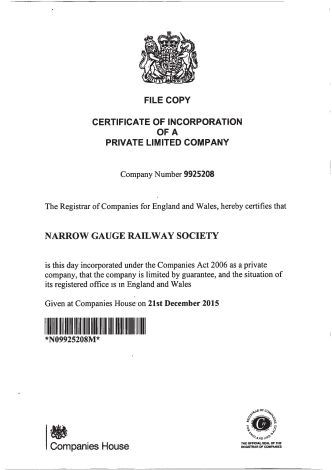NGRS CONSTITUTION
|
Purpose of the
Society · Narrow gauge railways – promote interest in, issue publications on, visit and preserve documentary artefacts. Also encourage formation of local groups, separate from the Society (Article 2) · Each member’s liability limited to £1 if ever the Society is wound up (Article 3).
How the
directors are appointed and how they should act · Directors must be a member of the Society (Article 18(1)). · Up to 12 directors can be appointed (Article 18(2)). · New director appointed either by vote at a general meeting or by decision of the directors (Article 19(1)). · Arrangements for nominating new directors at a general meeting (Article 19(2) – (4)). · All directors to retire from office at each AGM, but can be reappointed (Article 20). · Situations where a director’s appointment is terminated (Article 21). · Directors may not be paid but their expenses can be reimbursed (Articles 22 and 23). · Directors must take decisions collectively (Article 8), with a minimum quorum of 5 (Article 12). · Directors do not have to be in the same place to hold a meeting, providing they can all participate, allowing meetings by telephone or electronic means (Article 11). · Directors can delegate to a person or sub-committee (Articles 6 and 7). · Chairman has a casting vote (Article 14). · Arrangements if ever a director has a conflict of interest (Article 15). |
Click the document to see a full sized PDF version. |
Basic rules of
membership and conduct of members’ meetings
· People who, at 1 April 2016, were members of the unincorporated body called Narrow Gauge Railway Society became members of the Society at that date – until their membership of the former society would have ceased (Article 24 (1)).
· Otherwise, a person becomes a member by completing an application and paying an annual subscription, as determined by the directors (Article 24(2) and (3)).
· The Society can have different classes of membership, each with its own subscription (Articles 25 and 26).
· Situations where membership terminates (Article 27).
· Quorum at an AGM is lower of 25 or 1/10th of the membership, in person or by proxy (Article 29).
· Members’ meetings do not need everyone to be in the same place, provided they can communicate with each other (Article 28).
· Arrangements for adjourning a meeting (Article 32).
· Each member to have one vote (Article 33).
· Rules for voting on a poll (Article 35) and proxy voting (Articles 36 and 37).
Financial and
administrative arrangements
· The income and property of the Society should be used to promote its purpose (Article 39).
· The Society’s income and property cannot be used to pay dividends to any member (Article 40).
· If the Society is dissolved, its remaining assets can be used only for certain purposes, and cannot be distributed among the members (Article 41).
· Communication can be in any way allowed under the Companies Act 2006 (Article 42).
· The directors can create reasonable rules and bye-laws (Article 43).
· Members have no general right to inspect the accounting records (Article 45).
· The Society may indemnify the directors out of its assets and may take out indemnity insurance (Articles 47 and 48).
